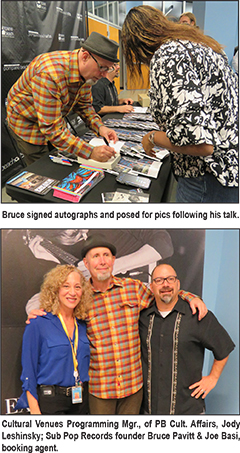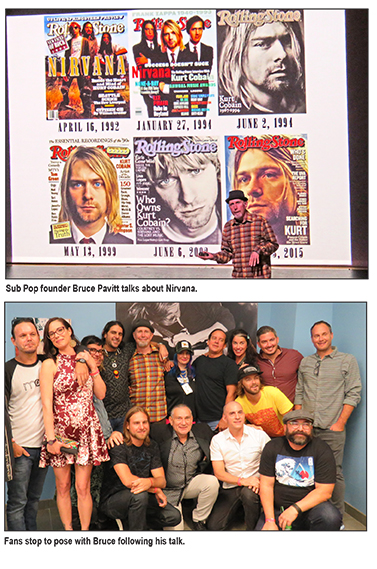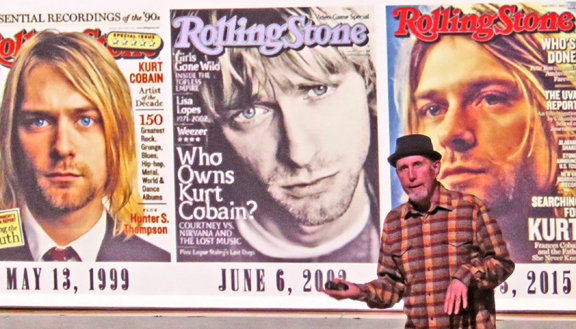
By Rachel Galvin
When grunge came on the scene in the 1990s, the soul-searching rough-around-the-edges musicians were such a departure from the glossed-up, big-haired entertainers that hit the charts in the Me decade that preceded it. One of the biggest names in the flood of newcomers in the ‘90s was Nirvana and the band’s angst-filled frontman Kurt Cobain.
Sub Pop Records owner Bruce Pavitt got to know the tortured artist and gave his insights into him, the band and the evolution of the music industry in a special event held Sept. 21 at the Pompano Beach Cultural Center. The packed audience of about 200 people watched as he showed many of the photos that were taken during a European tour in 1989, pictures that are in his new book called Experiencing Nirvana.
After Sub Pop Records popped on the scene in the late ‘80s, their name and logo became ubiquitous. But few knew the struggles going on behind the scene as Pavitt and his partner Jonathan Poneman spent their time on the phone promoting their artists and sending out materials, working to keep the phone line from being disconnected. They managed heavy hitters in the indie world like Soundgarden and Mudhoney but it seemed that Nirvana might be their golden ticket. They continue to “represent the spirit of independent creativity” to this day.
Cobain, according to Pavitt, was a humble, quiet, sensitive soul. He was an animal lover. He owned gerbils and rabbits. He also had a sense of humor. His simple dreams included having a single played on the local radio station and “maybe opening up a petting zoo.”
He never had an inkling of the fame he would attain. His ripped up jeans, thrown-on vintage thrift store T-shirts and plaid flannel would become part of the look of an age, and people would be devastated when he was gone, a life lost too soon.
There was a glimpse of what lied beneath the artist during that European tour. On one stage in particular, Pavitt mentioned that Cobain “had a nervous breakdown,” jumping up on the PA system and smashing a guitar (which he was known to do). He was distraught. When Pavitt spent time with him trying to understand, Cobain said that when he looked into the audience, all he saw were the kids who bullied him in high school.

Pavitt talked about how the ‘90s really became very “inclusive.” Instead of people feeling like they were watching an exhibition, they could look at the ‘90s artists and what they were wearing and say, “I have a flannel shirt” (for example), put it on and feel a part of the group. In the ‘80s, everything “felt very excessive,” he said. The clothes, hair and style all were too expensive for the average person.
The feeling of being part of the group that the ‘90s brought was also captured in energetic photos by photographer Charles Peterson, photos used by Sub Pop.
Sub Pop has always been about capitalizing on the independent spirit, the regional market, knowing there is something intrinsic about a sense of tribal identity. Before grunge hit, people couldn’t find Seattle on a map, he said. But, after, a lot of people moved there and the area got international attention as people strove to understand the “Seattle sound.” BBC writer John Peel wrote a great article mentioning Sub Pop in 1989 that helped to get them on the map as well.
Asked where the next regional movement in music is, Pavitt responded, “Los Angeles” and mentioned Billie Eilish, who recently made an appearance on SNL and elsewhere, and graces the current cover of Elle and can be seen elsewhere. She has been around for awhile, but her star certainly seems to have grown brighter lately. Perhaps her rise to fame is because she stands out from the crowd and rebels much in the way Cobain did, although his seemed less purposeful. One noteworthy example is that Cobain refused to be on the cover of Rolling Stone Magazine unless he could wear a T-shirt that said “Corporate magazines still suck.” (Magazine cover in picture above, top left).
Whatever he did, Cobain went from obscurity to one of the biggest stars around in a short period of time. By 1992, he had sold four million copies of his record.
Pavitt added, “Every once in a while, things come together and an artist breaks through. I live for those moments.”
Nirvana would be spirited away by Geffen Records and left Sub Pop behind, but Cobain’s talent and memory made a huge impression on the record label and on Pavitt.
He said, “People would come up to me and tell me where they were when they heard ‘Smells Like Teen Spirit,’” which was on the next album Nirvana did after leaving Sub Pop, telling stories of the impression the music made on people.
Pavitt commented on the evolution of music.
“People don’t buy music. They rent music. It is amazing record stores even exist [mentioning he stopped by Sweat Records in Miami]. Streaming is here to stay,” he said. “[This generation is] not going to read an article. They will read a headline. When I was younger, I read the article, drove to the city, got the record, read the liner notes and thought about it.”
His “manic relationship with music” started at a young age. When he was 9 years old, he worked hard to make money to buy a record player. He never thought he would make money doing this, but said if you are working with people you want to spend time with and doing what you love, then it is not work; it is play.
“There is always going to be art in society, always creative stuff. The trick is getting exposure to creative people,” he said.
There is a movie in the works about his own creative journey and that of Sub Pop, which just celebrated its 30th anniversary on Aug. 11, 2018. For more information on what Sub Pop is up to now, visit www.subpop.com.







